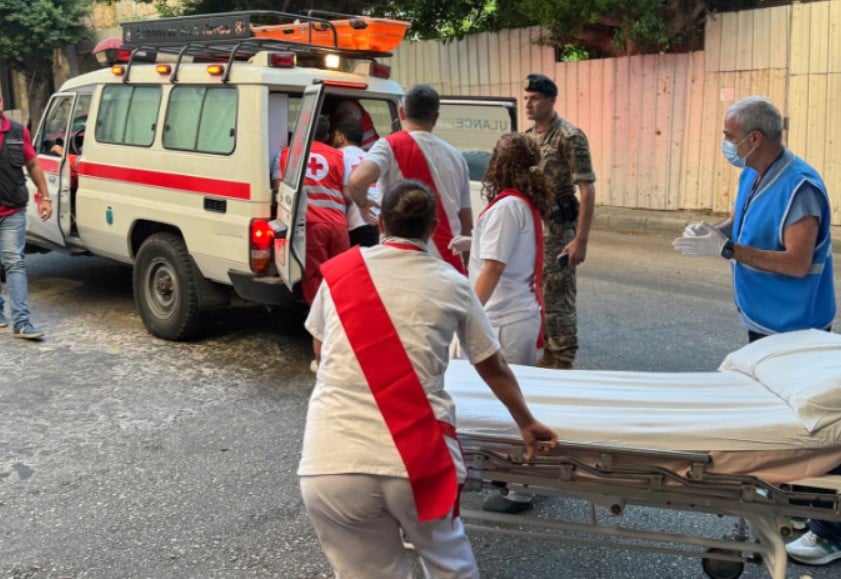Diplomats and UN officials demean themselves and the organizations they represent when they purposely ignore law and dishonestly and for political purposes only betray its letter and spirit.
By Elizabeth Samson, Middle East Forum
Many analysts heralded this week’s synchronized explosions across parts of Lebanon of pagers, walkie-talkies, and solar equipment as operational genius in Israel’s war against Hezbollah.
After all, the attack was extraordinarily precise, disrupted internal communications, and hemorrhaged the terror group’s morale.
Many in the United Nations, human rights workers, European diplomats, and progressive politicians disagreed and condemned Israel for allegedly violating international law.
The Israeli attack on Hezbollah did not come out of nowhere.
Following Hamas’s October 7, 2023, attack on Israel, Hezbollah began launching missiles and drones into Israel, leading tens of thousands of Israeli civilians to flee their homes and forcing the Israel Defense Forces to stretch its resources.
Hezbollah had previously ceased using cell phones because of concerns about cybersecurity, forcing a switch to pagers as a seemingly safer and low-tech alternative.
Israeli intelligence apparently infiltrated the supply chain, rigging the devices to set off simultaneous detonations upon receipt of a specific signal.
UN High Commissioner for Human Rights Volker Türk condemned Israel. “Simultaneous targeting of thousands of individuals, whether civilians or members of armed groups, without knowledge as to who was in possession of the targeted devices, their location and their surroundings at the time of the attack, violates international human rights law and, to the extent applicable, international humanitarian law,” he explained, calling for an investigation.
Yet, he ignores that Israel targeted Hezbollah’s low-tech devices with knowledge that few if anyone outside Hezbollah would have this series of devices that Hezbollah distributed exclusively to its members.
UN Secretary-General Antonio Guterres’s statement that governments should not “weaponize civilian objects” is also cynical, considering his office’s recent controversial omission from its annual Children and Armed Conflict report of Hamas’s use of its own civilian population, particularly children, as human shields.
Putting aside the double standards held by the international community and the reflexive critique of Israel’s actions without acquisition of facts, and accepting that humanitarian law prohibits the intentional targeting of civilians during armed conflict, Israel’s operation nevertheless complied with international law.
The United Nations Convention on Certain Conventional Weapons (CCW), to which Israel is party, addresses the question of intent in military operations and defines relevant terms.
Protocol III of the CCW prohibits the use of weapons primarily designed to set fire to objects or cause burn injuries against civilians, outside an incident that has a clear military objective, and Amended Protocol II covers booby-traps and improvised explosive devices and distinguishes between military and civilian targets.
CCW Amended Protocol II, Article 2, defines “booby-trap” as a device which can kill or injure, and which functions unexpectedly when a person disturbs or approaches an apparently harmless object or performs an apparently safe act, and “other devices” to include manually-emplaced munitions and devices such as improvised explosive devices designed to kill, injure or damage and which are actuated manually, by remote control, or automatically after a lapse of time.
Here, an example of an illicit booby-trap device would be the explosives disguised by the Soviet Union to look like toys that they then dropped on Afghan villages in the 1980s to kill and maim Afghan children.
Article 2 also defines “military objective” as any object which by its nature, location, purpose, or use makes an effective contribution to military action and whose total or partial destruction, capture, or neutralization offers a definite military advantage, and “civilian objects” as all objects which are not military objectives.
What makes an item prohibited is its arena of use—whether it targets a clear military or civilian objective. A device being booby-trapped, or an improvised explosive device, does not alone make its use prohibited.
Likewise, a device that incidentally sets fire to objects or causes burn injuries is prohibited only if its use has no clear military objective.
Whether the attacks in Lebanon rise to the level of actions prohibited under international law is a question of intent and, in this case, there was no intent to harm civilians operating outside a designated terror organization that has unilaterally and openly waged war on Israel.
Israel’s targeting of Hezbollah through pagers—purchased by Hezbollah for terror operatives to use in waging an asymmetric war—were solely “military objectives” and not “civilian objects” in accordance with the definitions outlined in the CCW.
Incidental loss of civilian life, while unfortunate, is the byproduct of a terror group choosing to operate among innocents.
Waging war from civilian territory leaves those who seek to fight terrorism little choice but to fight on the terrain the terrorists lay out.
Hezbollah has made all Lebanon its battlefield, without regard for civilian life. Israel has no choice but to bring the war home to them, and it did so legally.
Diplomats and UN officials demean themselves and the organizations they represent when they purposely ignore law and dishonestly and for political purposes only betray its letter and spirit.


